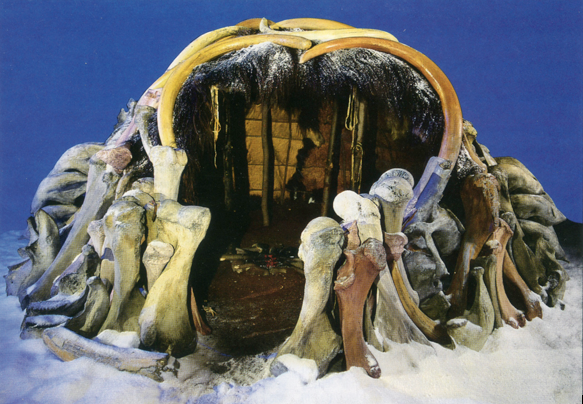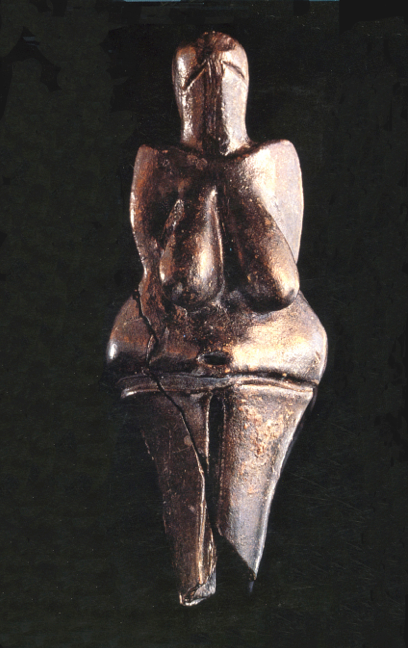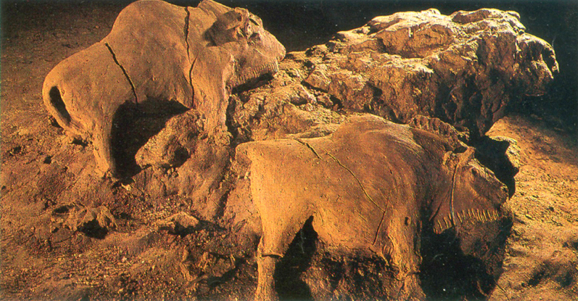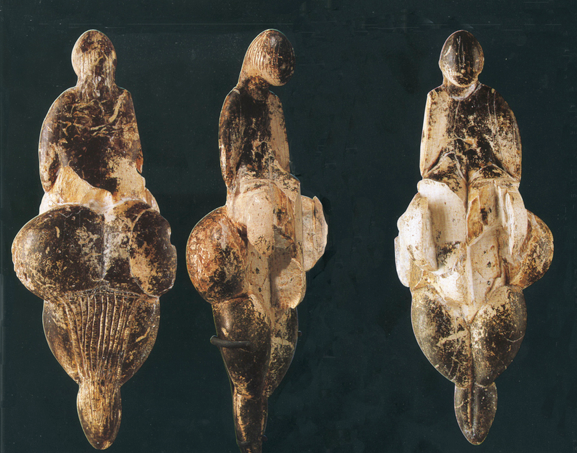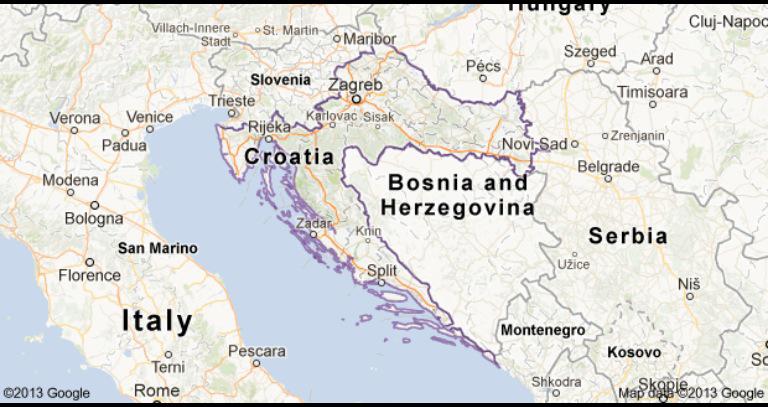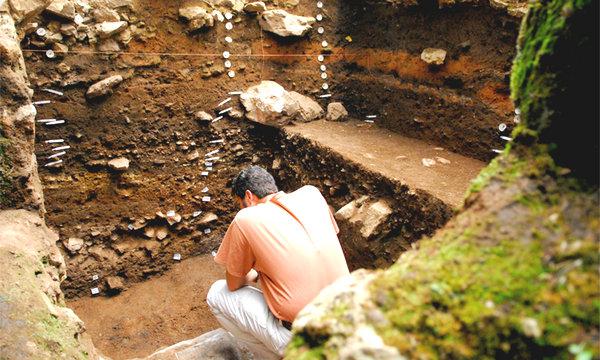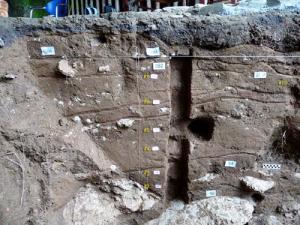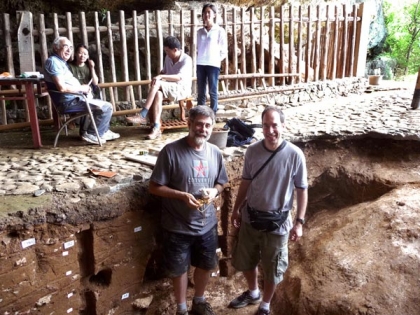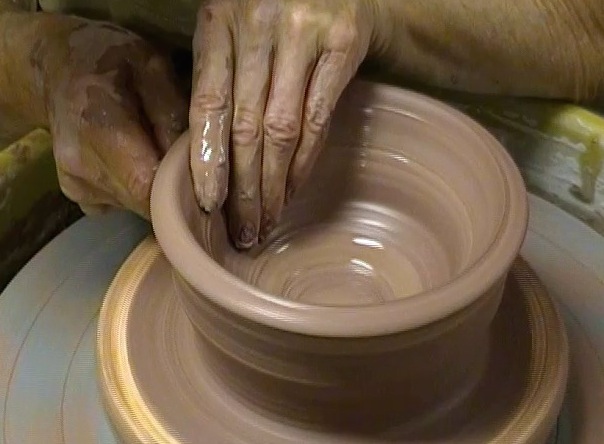JAYNE SHATZ POTTERY
PhD-Prehistoric Ceramics
MA- Pottery and Sculpture
BA - Art History
ICE AGE CERAMICS
EXPLORING CLAY FROM THE ICE AGE TO THE LATE NEOLITHIC- AN INQUIRY INTO PREHISTORY
40,000 BPE- 100 BPE
Why did art of this brilliance emerge from a society so concerned with the ferocity of every day ? I believe it is Humankind's desire to control the forces of nature, align themselves with spiritual beliefs, and become integrated with the realms of their established position with respect to the nature,god,human cycle. These Ice Age people saw themselves as part of nature, and had the capacity to realize they could be influential to the outcome of events.
They lived their lives with a strong relationship to wild animals and the changing of the seasons. Their paintings,
engravings, and sculptures express a spiritual quest to have their lives richer and more beautiful. As they evolved, they began to socialize with other tribes, and learned to cooperate with each other for successful hunts. They used ritual and belief to assure themselves of a better life. With more efficient tools, and their homes secure, they became non nomadic. Food was plentiful as the glaciers receded and a more moderate climate was established. As life settled down, they found leisure time to concentrate on their spirituality and its manifestation:art. An understanding of the development of humankind and their approach to art provides the ceramic artist with a heritage that dates back 30,000 years. Through archaeological excavations and anthropological assimilation of collected artifacts, a wondrous picture of our first ceramists has been painted. As ceramists, we can feel proud of the duration of our art and witness its vital contribution as a major art form.
As artists, and ceramists in particular, to imagine a person modeling a figure in clay, almost 30,000 years ago, enables us to feel kin to the artistic urges of the Prehistoric people. To fire clay and make it more permanent, is the way of ceramists. Our art is a part of Human development, a part so powerful it has been preserved through time for us to view and touch.
We know a great deal about the prehistoric culture through information that is generally accepted and compiled by leading scholars throughout the world. One treatise in particular for the United Nations Educational,Scientific, and Cultural Organization (UNESCO), provided the foundation for such a compilation of information on prehistoric cultures, derived from archaeological excavations. In this text, archaeologist Jacquetta Hawkes, presented one of the first reviews on prehistory, which then became the basis for much of the discourse on prehistoric cultures.
The world's first art movement occurred during the Upper Paleolithic period of the Great Stone Age Toolmakers around 30,000 years ago. This movement flourished during the last Ice Age until the glaciers finally melted away by 11,000 BC. The climate was harsh by our standards, with temperatures ranging from -10 degrees Fahrenheit in the winter to 55 degrees in the summer months. The ice lay a mile and a half thick in some places with snow and ice accumulating into mountainous ocean peaks, creating low sea levels and large land masses.
PERIODS IN PREHISTORY
2-3 MILLION YEARS AGO THE FIRST TOOL MAKERS
THE FIRST TOOL MAKERS
130,000 BPE 

 NEANDERTHAL
NEANDERTHAL
40,000 


 BPE CRO-MAGNON
BPE CRO-MAGNON
32,000 BPE


 FIRST SCULPTURES
FIRST SCULPTURES
27,000 BPE


 FIRST KILN SITE-VENUS FIGURINES
FIRST KILN SITE-VENUS FIGURINES
20,000 BPE


 SEWING NEEDLE
SEWING NEEDLE
15,000 


 BPE CAVE ART
BPE CAVE ART
14,000 


 BPE WEAPONS (Spear, Bow and Arrow)
BPE WEAPONS (Spear, Bow and Arrow)
11,000 BPE ICE AGE ENDS- (Glaciers Retreat)
BPE ICE AGE ENDS- (Glaciers Retreat)
A small black figurine sculpted from clay and bone ash was found intact at the Dolni Vestunice kilnsite. Alexander Marshack, expert in Ice Age art, from Harvard University, described the figure as one of the earliest "Venus" figurines, displaying large voluminous breasts, angular shoulders, and legs tapering down to small rounded points, indicating the image was meant to be carried or laid down as an idol. The top of the head had four holes made to either hold flowers, leaves, or feathers, symbolizing the successful changing of the seasons, which were attributed to the fertility of the goddesses. The female figure predominates Paleolithic small sculpture. She personifies the continuity of the species, the magical invocation of the survival of the race. The severity of form is due to its minimal representation of womanhood abundant with life. Later on these figurines displayed a vulva which became known as the "mound of venus", eternally receptive to life and the archetype of universal fertility.
In an article in SCIENCE magazine, written by P. Vandiver, O. Soffer, B. Klima, and J. Svoboda, entitled,"The Origins of Ceramic Technology at Dolni Vestonice, Czechoslovakia", (1990), the most recent information on the composition of the clay found at the Dolni Vestonice cavesite for the production of these Venus figurines has been examined. The article also provides new information on other prehistoric sites that contain ceramic artifacts found in the European area. 10 More and more investigations are being done by archaeologists on the ceramic artwork of the Upper Paleolithic period.
Another found treasure trove in prehistoric ceramics was the discovery of a small cave in France, hidden in the hills of the Pyrenees. Inside this cave were found two sculpted bison, 24" and 25" long, dating from 15,000 BC. Upon viewing these unfired sculptures, an incredible vitality of form, beautifully executed in detail is expressed through the strong finger marks impressed onto the clay surface by the artist.
This extremely sophisticated high relief representation shows the movement of the artist's fingers across the clay to be decisive, spontaneous, and amazingly adept. This sculptor knew the bison form intimately, and with a vigorous drive, crawled into a tiny mouthed opening to the cave, presumably on his or her belly, to sculpt the animals, and never to return. These bison were sculpted from an existing mound of clay, and due to the protective circumstances of this particular cave, remained intact for thousands of years. How many more sculptures were created in caves such as these only to be melted away from dampness and rain? From the sophistication in detail and aptitude, I believe that an artistic heritage had been developed by this time and this was not a singular occurrence.
One area was unique to Continental Europe. There existed an ice free corridor, laying between the large ice sheet in the North and the icy mountains of the Alps. This land mass of grassy hills created a tundra with a moderate climate that stretched from Czechoslovakia through Poland into the Ukraine and Siberia. Whereas in the icy parts of Europe the cold loving reindeer, wooly rhinoceros and ibex dwelled, these warmer regions saw herds of mammoth roaming alongside communal tribes of mammoth hunters. Early Homo sapiens were stone tool makers, and archaeologists refer to this period as the Late Stone Age.
The Upper Paleolithic, or Ice Age, was a time of spontaneous evolution in the development of art, music, and tool technology. What is amazing about this period is that it seems to have suddenly appeared on the horizon without any precedence in the evolutionary process. In John Pfeiffer's, "The Emergence of Humankind", he terms this period as an "Evolutionary Explosion". The earlier Neanderthal culture did have tool kits, with some objects carved smooth to comfortably fit the hand, and some displaying deliberate scratch marks. But nothing of any artistic value has been discovered that can explain the explosion in art that was to follow.
This cultural blossoming of the Ice Age is similar to the artistic revolutions in 13th century Sung Dynastic China and 15th century Renaissance Europe. During these times, Humankind developed a cultural heritage through their painting, sculpture, music, and literature, that mirrored the creative urges of the soul. As these individual art forms developed within a culture, they contributed to the growth of one another. I believe that these unique periods of renaissance occur when political, economic, and philosophical social structures are ready to burst forth with experimentation and new thought, within a supportive, creative environment. The Paleolithic culture exemplified such an artistic revolution.
With a fervent burst of sophisticated artistic aptitude, the Ice Age artists crawled into caves holding chisels, brushes, and pigments, to paint, carve, and sculpt in the deep recesses of the earth with only a simple oil lamp to guide their way. The paintings in the caves of Northern Europe are so dynamic and colorful that the feeling of a cathedral or chapel is achieved. Their murals of bison, horses, and the hunt, depicting the lives and symbolism of the prehistoric world are comparable to the ceiling of Michelangelo's Sistine Chapel in energy, force, and artistic expression.
The huts were situated alongside a stream, with the main posts of wood set into the ground. The remaining framework for the walls and roofs were of large mammoth bones and tusks. A wall of bone, brush, and dirt surrounded the hut, providing shelter from animals and cold winds. The oval floor was specially prepared from the hollowed slope of a hill, and laid with a limestone grit. Inside the huts were hearths made from a shallow depression in the flooring ringed with flat stones. The two larger huts had five hearths each and it is believed that they were the communal dwelling of a hunting clan. In particular, the smaller circular hut with similar flooring, was entirely enclosed in a wall of limestone and clay. The hearth in the middle provided a spectacular discovery in ceramic history. A prehistoric kiln in the shape of a "beehive" was surrounded by thousands of clay pellets, attesting to the ceramic modeler's work. Along with these pellets were found fragments of the heads of two bears and a fox and some unfinished statuettes. Some archaeologists believe this 30,000 year old kiln to be the oldest kiln ever to be discovered. It is thought to be the home of a Paleolithic Shamen, the sacred hut where the figurines of women and beasts to be used in fertility rites were produced and then fired.
ICE AGE HUT, MAMMOTH BONES, MUSEUM RECONSTRUCTION OF 30,000 BPE
DOLNI VESTONICE –Female figurine, “Venus”, smoke biscuit fired clay, 27,000 BPE
BISON, Le Tuc D’Audoubert Cave, France, 17,000 BPE
VENUSES of LESPUGUE, Ivory, 22.000 BPE, 5 1/2 inches
VENUS LAUSSEL, Cave Wall Carving, 20,000 BPE
This article was published in Ceramics Monthly Magazine, Feb. 1992, pp. 78-79
There have been new archeological excavation discoveries in the past ten years. Recently, in 2012, these findings have been published in newspapers, the internet and scientific and archaeological abstracts over the world. These discoveries are very exciting, and bring new light onto some previous subjects, and tend to validate those findings.
The Ela Spila Cave, Croatia
36 fragments from modelled animals were found at a limestone cave in Croatia, were probably from a culture that developed over 17,500 years ago, or 19,000 BPE. This discovery adds to the knowledge base of the first humans that developed clay making. The archeologists that worked on this cave site believe that the first clay makers had artistic inclinations, rather than a need for pottery. Therefore, fired modelled figures were usually developed first within a culture. This new information also substantiates the theory that art develops independently for different cultures.
The pieces were made with great care, evidently by true artisans. One of the pieces is a torso and foreleg of a horse or deer, with incisions that indicate several kinds of tools were employed.
What I find outstanding is that this discovery makes reference to the Doni Vestonice figurines, which were probably produced a full 10,000 years PRIOR to these clay pieces. Olga Soffer, the professor of anthropology worked on the writings of the Vestonice venuses, which emanated from the area we now know of as the Check Republic. These figurines were made in an outdoor hearth, or kiln, which makes this firing device the oldest known kiln.
About 10,000 years later in Croatia, the appearance of functional pottery occurred at the Vela Spila site.
The Xianrendong Cave, China, 17,000-18,000 BPE
The discoveries in this cave in southeast China present an even more interesting understanding of the development of clay making. In this particular cave, more than one hundred fragments of pottery were found since the 1960's, that is clearly thouands of years before farming began. Farming begins with the Early Neolithic cultures around 12,000 BPE, and with farming usually comes the need to store food stuffs, which in turn, advances the need for fired pottery. This discovery places these potters in the Paleolithic hunter gatherer period, which were a people that were usually nomadic and had no need for storage vessels. One theory is that there was such extreme cold weather, a food storage could have happened, and since cooked food provides more energy than raw, people were placing their food on the fires, therefore cooking and eating from pots become important. Clams and snails were probably boiled in pots, as evidences of clam and snail shells were unearthed in this cave site.
Animal carving fragments, Vela Spila Cave, Croatia, 17,500 BPE
Croatia Map
Archeologists at ela Spila Cave, Croatia
Xianrendong Cave, China, with labeled fragments, from 17,0009-18,000 BPE
Xianrendong Cave, China, 20,000 year old cookware
Xianrendong Cave, China, archeologists
New archeological excavation discoveries, documented 2012
What I am beginning to comprehend, is that the field of archeology is fluid and continually changing. With new excavations, we learn more about our ancestors, and therefore, more about ourselves. No matter how far back in time we travel, I still believe that the ceramic artisans of thousands of years ago had the same drive, yearnig and need to create pottery and sculpture as I do today!xtW. W
